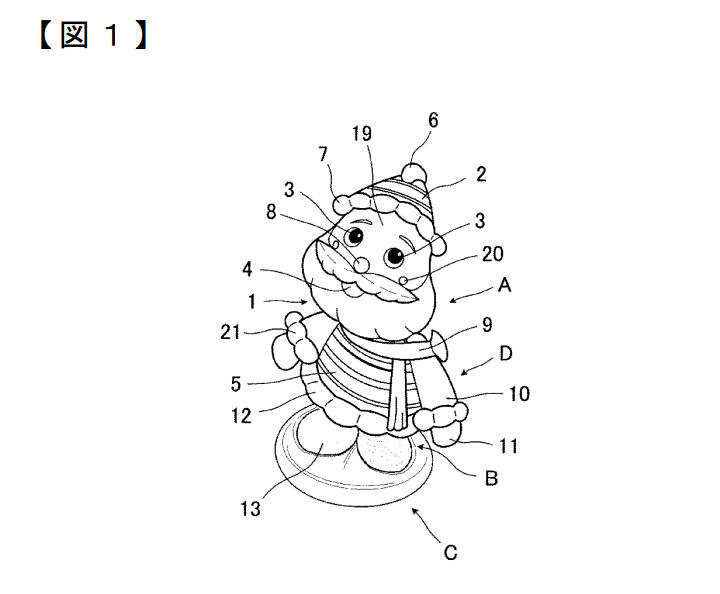
- Introduction: Festive Sweets That Bring Santa to the Table
- What the Patent Drawing Shows
- How the Edible Santa Construction Works
- Benefits for Confectionery Brands and Seasonal Products
- Engineering & Food-Design Considerations
- Patent Attorney’s Thoughts
- Application of the Technology: Edible Micro-Avatar Fabrication and Seasonal Identity Replication Systems
Introduction: Festive Sweets That Bring Santa to the Table
Holiday treats often carry a sense of delight and celebration. This patent drawing presents a decorative edible Santa Claus sweet, designed to combine visual charm with edible enjoyment, making it ideal for seasonal treats, gifts, or children’s desserts.
What the Patent Drawing Shows
The diagram reveals a structured confection composed of multiple edible components:
- A Santa Claus figure formed from layered sweets
- Distinct zones for hat, beard, face, and clothing
- Use of different textures—marshmallow, chocolate, candy paste
- Positioning of decorative edible parts such as eyes, nose, and belt
- A base or support layer that maintains shape during packaging
The sweet balances aesthetics, structural integrity, and deliciousness.
How the Edible Santa Construction Works
Each part of Santa is crafted separately with a specific ingredient:
- Soft edible materials form the face and beard
- Colored confections create the hat and outfit
- Small edible accents complete facial features
- Heat-resistant or moisture-resistant materials protect shape
- Assembly follows a layered process to maintain form and clarity
The treat becomes a playful edible character.
Benefits for Confectionery Brands and Seasonal Products
- High visual appeal for holiday markets
- Suitable for gift boxes, children’s snacks, or bakery displays
- Easy to customize with variations in color or expression
- Can be mass-produced with molds and simple manual assembly
- Enhances emotional engagement and seasonal atmosphere
It merges craftsmanship with festive cheer.
Engineering & Food-Design Considerations
- Ingredient hardness must balance between shape stability and chewability
- Food coloring requires safety and durability against moisture
- Structural alignment ensures the face remains recognizable
- Packaging must protect delicate decorative parts
- Manufacturing must support high-volume seasonal demand
Food design meets holiday creativity.
Patent Attorney’s Thoughts
Taste becomes memory when wrapped in charm.
By shaping sweets into a familiar festive figure, this invention captures the warmth of the season in a single edible moment.
Application of the Technology: Edible Micro-Avatar Fabrication and Seasonal Identity Replication Systems
Original Key Points of the Invention
- A method for producing Santa-shaped edible sweets with distinct decorations.
- Layered construction allows separate colors and facial features to remain clear.
- Mold structures guide chocolate, sugar, or paste into precise figurine forms.
- The invention ensures stability of fine, delicate details during hardening.
Abstracted Concepts
- Fabricating small characters through layered edible material deposition.
- Maintaining high-fidelity micro-details in fragile structures.
- Using molds to encode identity into a consumable object.
- Reproducing symbolic “personae” in edible, dissolvable form.
Transposition Target
- A system that fabricates edible micro-avatars—tiny consumable beings representing moods, seasons, memories, or personal identities.
Concrete Realization
An edible-avatar printer deposits flavored gels, fat-based pastes, and crystalline sugars layer by layer.
Each avatar encodes a symbolic “state”: winter calmness, excitement, introspection, or celebration.
Users select a mood, and the machine fabricates a corresponding edible figure that embodies it.
The avatars dissolve on the tongue, releasing tailored flavor compounds linked to emotional states—an ingestible emotional interface where identity and sensation merge.
Holiday mascots are merely the starting point; entire emotional ecosystems become edible.
Disclaimer: This content is an AI-generated reinterpretation based on a patent drawing.
It is provided for educational and cultural purposes only, and not as legal advice.
↓Related drawing↓




